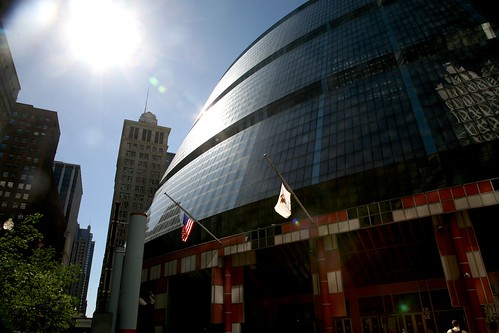Chicago (ILL) Downtown, James R. Thompson Center JRTC, 1985

Image by (vincent desjardins)
SOURCE : WIKIPEDIA
Français
James R. Thompson Center (ou JRTC) est un bâtiment situé au 100 W. Randolph Street dans le secteur communautaire du Loop à Chicago (Illinois, États-Unis). Il occupe la totalité de l’espace délimité par les rues Randolph, Lake, Clark et LaSalle.
Le bâtiment, qui a ouvert ses portes en mai 1985 sous le nom de State of Illinois Center, accueille une partie des bureaux du gouvernement de l’État de l’Illinois. Il a été renommé en 1993 pour honorer l’ancien gouverneur de l’Illinois James R. Thompson. Le JRTC est parfois aussi désigné sous le nom de State Building.
Le JRTC a été conçu par les architectes Murphy/Helmut Jahn et a été sujet à de vives polémiques, qualifié d’"horrible" par certains ou de "magnifique" par d’autres le jour de son ouverture. Tout l’extérieur de l’édifice est fait de verre, mais ne reflètant pas la fonction du bâtiment. L’image pure du postmodernisme donnée par l’ensemble produit un effet saisissant, surtout depuis le Richard J. Daley Center.
Le JRTC est également un important noeud de correspondance du métro de Chicago puisque six lignes (bleue, verte, brune, rose, mauve et orange) s’y croisent à la station Clark/Lake.
ENGLISH :
The James R. Thompson Center (JRTC) is located at 100 W. Randolph Street in the Loop, Chicago, Illinois and houses offices of the State of Illinois. The building opened in May 1985 as the State of Illinois Center. It was re-designed in 1993 to honor former Illinois Governor James R. Thompson. The property takes up the entire block bound by Randolph, Lake, Clark and LaSalle Streets, one of the 35 full-size city blocks within Chicago’s Loop. In front of the Thompson Center is a sculpture, Monument With Standing Beast, by Jean Dubuffet. The JRTC is sometimes referred to as the State Building.
The JRTC was designed by Murphy/Helmut Jahn and called "outrageous" or "wonderful" by critics when it opened. The color of the street-level panels was compared to tomato soup. The 17-story, all-glass exterior does not reflect the building’s function, and instead conveys an image of pure postmodernism; the effect is striking, especially from the Daley Center.[citation needed] Visitors to the JRTC’s interior can see all 17 floors layered partway around the building’s immense skylit atrium. The open-plan offices on each floor are supposed to carry the message of "an open government in action."[citation needed]
Originally, the design called for curved, insulated (double paned) glass panels, but these were found to be prohibitively expensive. Flat, insulated glass had been suggested, but were dismissed by Jahn. Single-paned (non-insulated), curved glass panels were eventually used and resulted in the need for a more expensive air conditioning system, which remains very costly to operate and is insufficient on hot days (internal temperatures have reached as high as 90 degrees Fahrenheit).[1] The building is also bitterly cold in the winter; in its early years, ice formed on the interior of some of the wall panels. The marble floor of the atrium initially developed unsightly water stains, an issue which has since been resolved.
The Clark/Lake ‘L’ station, one of the busiest in the system, is housed between the JRTC and the 203 N. LaSalle building across the street. Orange, Green, Blue, Pink, Purple and Brown Line trains stop at the center.
The Illinois Artisan’s shop is also housed inside the JRTC.
The Chicago Pedway connects from the building to 203 N. LaSalle, Chicago Title and Trust Company and Chicago City Hall.
Tags:1985, Center, chicago, downtown, James, JRTC, Thompson


0 comments:
Post a Comment